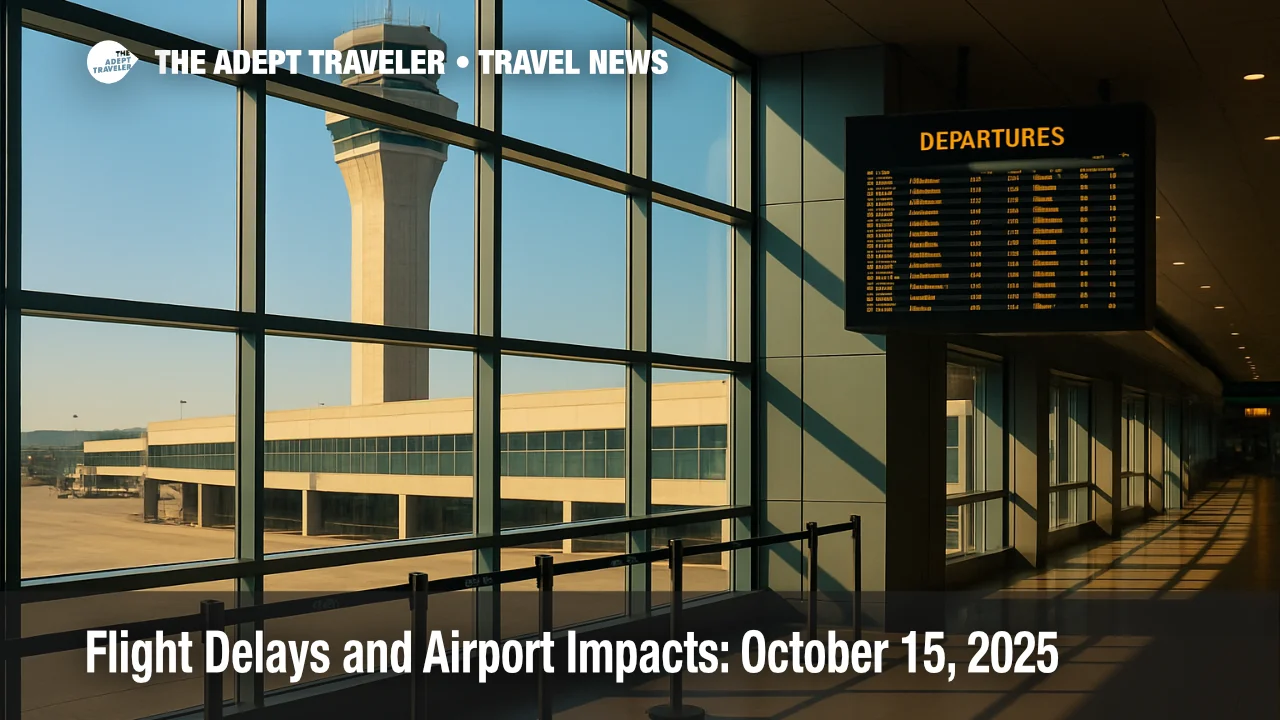Flight delays and airport impacts: October 15, 2025

San Francisco International Airport (SFO) is operating under a ground delay program this afternoon, while earlier fog at Denver International Airport (DEN) prompted an extended ground stop. The FAA's operations plan also flags possible ground stop or delay programs later for Newark Liberty International Airport (EWR), John F. Kennedy International Airport (JFK), Ronald Reagan Washington National Airport (DCA), and LaGuardia Airport (LGA). Winds, low ceilings, and scattered thunderstorms remain the main constraints across several centers.
Key points
- Why it matters: Arrival metering at SFO and ripple effects from DEN are pushing knock-on delays nationwide.
- Travel impact: Afternoon and evening banks may see longer taxi and connection times at West Coast and Northeast hubs.
- What's next: The FAA plans another briefing at 1715Z, with New York and D.C. programs possible if weather or volume worsens.
- Low ceilings at SFO and BOS, plus winds at New York TRACON, Philadelphia, Las Vegas, and Seattle, are limiting acceptance rates.
- Route advisories include Atlantic closure L455 due to thunderstorms and select capping or reroutes in the Midwest.
Snapshot
As of mid-afternoon, the FAA lists SFO under an active ground delay program through 2129Z, driven by low ceilings. DEN reported dense fog this morning that pushed the field into an extended ground stop for Category I and II arrivals before conditions improved. The national plan highlights additional pressure points, including potential ground stop or delay programs for EWR, JFK, DCA, and LGA into the late afternoon and evening. En route, thunderstorms are affecting New York and western centers, with the oceanic route L455 closed pending an update. Travelers should build extra buffer time for connections at West Coast and Northeast hubs, and monitor airline apps for revised gate times.
Background
Weather-driven initiatives across the Northeast earlier this week combined with staffing stress from the federal shutdown to increase the share of delays attributed to personnel. While today's triggers are primarily low ceilings, winds, and convective weather, thin staffing margins can slow recovery after each program cycle. Airports may step rates up as conditions improve, yet aircraft and crews remain out of position, which keeps delays elevated through evening pushes. For context on Tuesday's system and recovery dynamics, see our prior report, Flight delays and airport impacts: October 14, 2025. European labor actions are also creating transatlantic knock-ons; for details, see Belgium general strike disrupts flights and transit.
Latest developments
SFO metering continues as New York and D.C. programs loom
The FAA's October 15 operations plan lists SFO under an active ground delay program due to low ceilings, with acceptance managed by expected departure clearance times for originating airports. The plan also notes possible ground stop or delay programs for EWR after 1800Z, JFK after 2000Z, DCA after 2000Z, and LGA until 0200Z, depending on winds, ceilings, and demand. Earlier in the day, DEN entered an extended ground stop for fog, with the command center expecting improvement by 1600Z. En route constraints include thunderstorms across New York and western centers, plus the closure of North Atlantic route L455 pending a 2100Z update. Operators should anticipate capping or structured routes in parts of the Midwest and desert Southwest if convective activity builds. Airlines are adjusting block times and swap plans to protect evening schedules as initiatives evolve.
Analysis
Today's picture shows typical autumn friction amplified by thin recovery cushions. SFO's marine layer often triggers metering, but the compounding factor is simultaneous sensitivity in the New York and Washington complexes where winds and ceilings reduce throughput. When multiple hub complexes meter concurrently, schedule buffers compress, and delay assignments spread to cities far from the weather. DEN's morning fog added another kink by holding inbound flows and delaying aircraft turns. The oceanic L455 closure funnels transatlantic traffic onto fewer tracks, which raises airborne spacing and can push later arrival waves into the East Coast banks. If the shutdown persists, staffing variability is likely to increase the frequency and duration of initiatives even on marginal-weather days. Practical mitigations for travelers include booking earlier flights, choosing longer connection windows, and preferring nonstop options when available. For those with essential meetings, consider arriving the night before to avoid evening bank volatility.
Final thoughts
Expect rolling delays at SFO through late afternoon, with the possibility of added metering for New York and Washington if winds and low ceilings linger. Keep notifications enabled, pad your connections, and consider standby for earlier departures. We will continue to track FAA advisories and airline recovery actions tied to October 15 flight delays and airport impacts.
